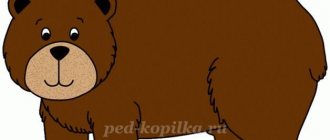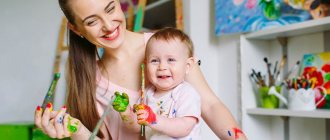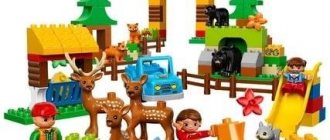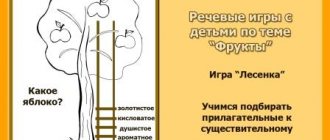No matter how old you are now, adults associate the word “mathematics” with school. Many people remember school lessons, and perhaps their teachers, but few parents can remember math classes in kindergarten. Namely, children from preschool age begin to form elementary mathematical concepts.
Many parents will think, “Why teach a child mathematics from the age of 3?” In our article we will try to explain in detail why a child needs math classes and what he should learn at 3-4 years old.
Learning to count from the age of 3
Taking into account the age characteristics of preschool children, mathematics classes differ significantly from lessons at school. For children attending kindergartens, learning is carried out in a playful way and in specially organized classes; children can reinforce the material with the help of didactic (developmental) games. There are specific tasks for each age group.
Mathematics classes develop children's logic and thinking. What ideas and skills should a 3-4 year old child acquire?
Quantity
At this age, children should understand that many objects consist of separate or homogeneous objects. For example, an adult asks children to find among the many rabbits the same one as he has in his hand.
Next, exercises are offered in which children select and group objects according to certain characteristics, for example: “Put all the blue balls in a basket, small mushrooms in one box, and large ones in another.” By completing tasks, children understand that all objects can be combined according to a certain characteristic.
Learn the concept of quantity from a picture
In order to teach 3-year-old children to understand the words “one” and “many,” the following exercise is proposed: in accordance with the number of children, apples are placed on the table. The adult draws attention to the fact that there are a lot of apples on the table, after which he asks each child to take an apple. The kids see that each time there are fewer and fewer apples, and as a result, “a lot” disappears. The adult says that each child has one apple, but there is not a single one on the table. After the adult invites the children to put one apple back on the table, they get a lot of apples again.
By teaching children 3–4 years old to compare groups of objects, an adult introduces the concepts of “equality” and “inequality.”
The game “Catch the fish” with a certain number.
For this, the overlay technique is used. For example, the card shows 5 kittens. The adult offers to “put” each kitten in a basket, placing a picture with the image of a basket under each kitten. Then he draws attention to the fact that there are “as many” baskets as there are kittens, which means “equally”. By removing one picture of a basket, children understand that there are “more” kittens and “fewer” baskets.
Lesson notes on the topic: One. A lot of. (age 3-4 years)
Lesson notes on the topic: One. A lot of. (age 3-4 years)
Target:
Learn to find many similar objects in the environment and isolate one object from it.
Objectives:
To introduce the concepts of “one”, “many”. Work on the ability to coordinate the numeral “one” with nouns in gender and case. Get acquainted with the concept of “right” and “left” hand. Form spatial concepts (the concepts of “in front of, behind, above”).
Materials:
a basket with balls of different colors according to the number of children + 1 ball for the teacher.
During the classes.
1. Children sit on the carpet and play with their fingers to the rhyme “Let's count our fingers.” 1, 2, 3, 4, 5 we will count fingers. (we bend our fingers) Here is a fist, and here is a palm. (Show fist and palm) A cat sat on the palm and sneaks away slowly, (Another palm moves along the palm, fingering it) Maybe a mouse lives there? The cat is guarding the mouse. Meow! (Like a cat scratching her palm with her fingers, and quickly hide her hands from the cat at the last word)
2. The teacher has a basket with balls of different colors according to the number of children +1 to the teacher. - What is in my basket? (Balls) - How many balls do I have in the basket? (A lot) - I’ll take one ball. I have one red ball. - Sasha, take the ball. How many balls did you take? What kind of ball do you have? You have one green ball. Repeat. (Distribute all the balls) - How many balls were in the basket? A lot of. - Now how much is left? No one.
There were a lot of balls, we took one at a time, and not a single ball was left. 3. Physical exercise.
Take the ball in your right hand. (The teacher stands facing the children and shows all movements in a mirror image) Transfer the ball to your left hand. Raise the ball above your head. Hide it behind your back. Hold the ball in front of you. Jumping in place with a ball in your hands to the poem:
Girls and boys jumped up and down like balls. They jumped, got tired, stood up on their toes, slowly spun around and sank onto the mat.
4. Let's collect the balls in a basket.
— How many balls are there in the basket? (None) - I will put 1 red ball in the basket. - Sasha, put the ball in the basket. How many balls did you put in? (Collect all the balls in a basket) - How many balls are in the basket? (Many) -We put one at a time, and there were a lot of them.
5.Game "Train".
We were sitting, we were tired, and now we stood up together. They stamped their feet and clapped their hands. We will assemble a locomotive to take us on a visit.
Children move in a group one after another to the song “The locomotive is moving, the locomotive is moving,” with their hands on the shoulders of the person in front. The locomotive “drives up” to a corner of nature.
- What items do we have a lot of? Which item is one? (Many cones, one squirrel) Take the one object and place it on the table.
“Drive up” to the construction corner. — What kinds of objects are there a lot? Which one? (Many blue cubes, one red.) Take 1 cube from those that are many and place it on the table.
“Drive up” to the doll corner. There are toys at the table. - How many bears? (One) How many dogs? (One) How many dolls? (One) How many cats? (One) How many toys are there in total? (A lot) Take 1 toy and put it on the table. etc.
“Drive up” to the table. - What's on the table? What are they needed for? - These are toys, they are needed for that. to play. How many toys are on the table? (A lot of)
—What else can you say “many” or “one” about? 6. Lesson summary.
Which game did you like best? You and I counted which items were many and which were one at a time.
Magnitude
Children 3–4 years old learn to compare different objects (blocks, strips of paper, ribbons) in width, length and height, and use the words: “longer - shorter”, “same in length”; “wider – narrower”, “equal in width”; “higher - lower”, “equal in height”; “more - less”, “equal in size”.
Cards for studying quantities “more and less”
At first, children learn to compare objects according to some specific characteristic. So, for example, by placing one ribbon on top of another, the children understand that the red ribbon is longer than the blue one, and the blue one is shorter than the red one.
After children learn to compare quantities and denote them in words, they can play the didactic game “Order”. An adult, on behalf of the doll, asks to bring a tall Christmas tree, a long path, a short ribbon, find a carrot of the same height...
Games on the concept of “more/less” can be bought in the store
Geometric figures
Children 3-4 years old are introduced to the square and circle. To do this, an adult gives each child different colored silhouettes of a square and a circle. Showing, for example, a blue square asks children to find the same figure in themselves. He does the same with a red circle, but does not say the name of the figure. Further examination of geometric figures takes place tactile-motor. The children repeatedly run their fingers along the outline of the figure and say its name.
The easiest way to study shapes is through play.
To reinforce the material, you can exercise the children and offer, for example, to put all the squares on the bottom strip, and the circles on the top; pick up the figure in your hand and name it; put the circles in a tray and the squares in a box or play the games “Guess what’s in the bag”, “Find the house”.
Orientation in space
At this age, children learn to navigate space “from themselves” and learn concepts such as: right (right), left (left), forward (in front), behind (behind), above, below.
When learning orientation in space, parts of the child’s body are taken as a basis: below is where the legs are, above is where the head is, behind is the back, and in front is the face, on the right is the right hand, and on the left is the left. The following exercises will help kids learn to navigate in space: “Wave the chicken with your right hand, then with your left”; “Where did the bunny jump” (up, down the hill); “Pull the flags forward (in front of you), hide them back (behind your back).
Orientation in space using cards
It should be borne in mind that when performing all exercises, all children should face the same direction, and the adult’s movements should be performed in a mirror image.
Time orientation
In everyday life, children learn to navigate time. A good helper will be strict adherence to the daily routine.
An adult introduces children to the parts of the day - morning, afternoon, evening, night. In the process of performing routine tasks, the adult says that it is morning, you and I woke up, washed ourselves, do exercises and have breakfast. Before lunch, you need to say that it is daytime, moms and dads are at work, and you and I are studying, walking, and having lunch.
Toy clock puzzles
To reinforce the parts of the day, you can invite children to look at pictures that will allow them to answer the questions: “What are the guys in the picture doing?”; “When we walk, do we sleep?” When reading works of art, you can invite children to point to a picture that is typical of people’s activities at a certain time of day (day, night, morning, evening).
We hope that all of the above exercises will help adults navigate correctly and contribute to high-quality mathematics classes with preschoolers.
leave a comment
Exercises
Exercise one
Look carefully at the following picture with your child. We need to answer questions.
Which ball is smaller?
Which ball is bigger?
What color is the little ball?
What color is the big ball?
How many balls are there in the picture?
Exercise two
In this exercise, you must correctly name the concepts high, low, small, large, one, many. Look carefully at each item.
MAGAZINE Preschooler.RF
Mathematical development plays a huge role in mental education and in the development of a child’s intelligence. Mathematics has a unique developmental effect. Its study contributes to the development of memory, speech, imagination, emotions; forms perseverance, patience, and creative potential of the individual.
Consequently, one of the most important tasks of preschool teachers is to develop a child’s interest in mathematics in preschool age. But childhood cannot be imagined without games, in this case didactic. Therefore, introducing mathematics through the use of game techniques will help the child to quickly and easily absorb the educational program.
Learning math doesn't have to be boring for a child. Children's memory is selective. A child learns only what interests, surprises, makes him happy or frightens him. He is unlikely to remember anything uninteresting, even if adults insist.
I present to your attention didactic games for children of the 2nd junior group to master mathematical concepts, means and methods of cognition.
“Choose a garage” Goal: To develop the ability to match items by size; height and length at the same time; ability to explain your choice. Assignment: Look at the picture and say what the names of the cars you see are called. The cars pulled up to the garages. Now everyone will take their place. Which? Questions for the child: -How will you distribute the cars among the garages? -Why is there only one car left? (The child chooses pairs - car and garage - and connects them with a line in the picture)
“Put things back in their place” Goal: To develop the ability to compare and distinguish objects; unite them according to a common characteristic. Task: Look at the drawing. The boy Dima and the girl Sveta have mixed up their clothes and cannot sort their things into the lockers. Questions: -How would you do it? - Name all the things and help the children not to confuse them. (The child puts things in cabinets)
“Where will you come? » Goal: Formation of skills to recognize and name figures, highlighting one or two features in them; size; shape and size. Problem situation: You want to treat the animals, but you can only get to them along the road through the stream. Assignment: Look at the stones in the stream. Questions: - What size are they? In form? - Who lives to the right of the stream? - Walk over the big rocks. Who have you come to?
“Which house did the three little pigs choose?” Purpose: To develop the ability to retain in memory the characteristics of objects (shape, quantity) and to find an object based on comparison. Assignment: Look at the houses: roofs, walls, windows, doors. Three little pigs choose houses for themselves. Nif-Nif (he with the shovel) wants to live in a house with three windows. - What house did he choose for himself? — Nuf-Nuf (he with the ruler) wants to live in a house with a triangular roof. Show me which house he chose? — Naf-Naf wants to live in a house without a pipe. What kind of house did he choose for himself? Then Naf-Naf thought and said: “Let’s all live together in one house that Nif-Nif, Nuf-Nuf, and I would like.”
- Which house did they choose? Tell me what kind of roof it has, and who wanted one? How many windows are there in the house? Which pig wanted so much?
— Does the house have a chimney? For whom was this important?
(With a triangular roof without a chimney, with three windows)
"Birthday"
Goal: Formation of skills to practically establish the correspondence of objects by quantity, to form groups of objects according to one characteristic (quantity, to use the words “as much”, “three each”, “extra”
Assignment: Divide the treat equally between the children and determine what will be left if each child takes one banana, one candy and one juice box.
"Decorate the clown caps"
Goal: Formation of combinatorial skills in the process of alternating colored figures; ability to use the words “first”, “then”, “below”, “above”, “between”
Problem situation: Look at the picture. The clowns have the same caps. They often confuse them and wear the wrong one to performances. They decided to ask you to decorate the caps in such a way that they could distinguish one from the other. Make the patterns on the caps different.
Place colored circles on each clown's cap. Compare and explain how these caps differ from each other.
| Next > |




